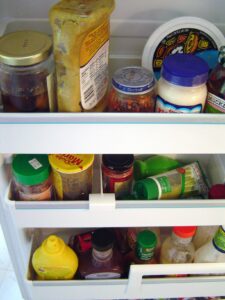Although my husband recently decided that reducing our plastic use was the right way to go to help save the environment, our health, and wildlife, I have been working on reducing our plastic use in our kitchen for a while now. I may not be comfortable recycling, throwing, or giving away our Tupperware (and most Tupperware is made from one of the plastic types considered safer for food use), but there were a long list of things we didn’t need to store in plastic. Plastic does tend to leach into the food with which it comes into contact, so storing in plastic means eating some plastic, a disconcerting notion. How did we reduce our kitchen-based plastic use? Check it out:
Leftovers
- Glass containers with plastic lids. Yes, they still have plastic lids, but if the appropriately-sized container is used, the food won’t come into contact with plastic, and the lid is removed for reheating. Bonus: I’m not worried about reheating in glass like I am with plastic, so there are fewer dirty dishes – I just use the glass container as my bowl.
- Regular dishes or mixing bowls covered in tinfoil, waxed paper, or reusable food wraps. If you don’t want to buy reusable food wraps, there are instructions online for making your own. Aluminum foil and waxed paper are not as sustainable as containers or reusable wraps, but they get the job done in a pinch, and sometimes you can use the same foil you used when cooking the food. Elastics or old hair elastics will help hold waxed paper onto your dish.
- Store it in the pot we cooked it in. If you plan on reheating it for the next day’s lunch or supper, why not leave it where it is and heat it up on the stove or in the oven?
- A dish on another dish. Fridges can be drying if you leave food for a few days, but if you plan to eat the food soon, why not put a bowl over top of the plate your food is on, and removing it when you’re ready to eat? Infinitely configurable and reusable.
- Store it in the package it came in. Although it isn’t necessarily plastic-free, at least we’re not using *more* plastic to store it.
- Glass containers with stainless steel lids, or metal containers with metal lids. They’re not cheap, but places like Life Without Plastic sells plastic-free containers that meet any 100% plastic-free needs or desires. We don’t have any of these at this time.
- Keep liquid leftovers in mason or other glass jars. The metal lids of glass jars are often lined with plastic, but at least if we keep our food upright the lid lining won’t contact the food.

Photo by Kaboompics.com
Water
- If you use a filter jug, consider filtering your water at the source, or making your own carbon filter to place in a glass or metal jug. We have whole home filtration for chlorine and other things because of my skin sensitivity, so we bought a stainless steel, lidded jug to chill water in our fridge. If you need to filter only your drinking water, there are online retailers of carbon sticks and granules for home use. If you can, avoid using plastic-based filter cartridges that require regular replacement.
- Use a stainless steel water bottle rather than buying or using plastic ones. You can even buy them with plastic-free or mostly plastic-free lids.
Cupboard storage
- Use mason or other glass jars to store dry goods like sugar, salt, nuts, raisins, grains, flours, beans, lentils, and more. This has been simple to implement, and it’s much easier to organize the jars in our cupboard.
- The first time you buy a spice or other pre-made food, buy it in a glass bottle. After that, buy it in bulk whenever you can and refill. Some places will even let you take your own containers to fill, providing you a tare weight ahead of time. If you can’t use your own containers when you shop, make sure to recycle the plastic bags after use. Grocery stores will often have a bag recycling bin available near the entrance/exit.
- Use paper labels if reusing a jar for something different than the product that came in it.
 Fridge
Fridge
- Avoid buying individual serving yogurt cups – they’re often not recyclable. Instead, stick with big tubs. Not only are they usually recyclable, but they can be reused for many things before recycling. Yogurt tubs make great plant pots. If you’re feeling really ambitious, make your own yogurt and store it in glass jars.
- Grow your own veggies or pick up local food when you can. Buy or make your own plastic-free produce bags so that you don’t have to bring the grocery store ones home anymore.
- Place cut fruits with their cut face down on a plate to reduce evaporative moisture loss.
I seem to remember way back when, as a toddler, when I would go with my grandma to the grocery store. She always took her glass peanut butter jar for my grandpa, the honey container for some new honey, and some plastic pop bottles to refill at the pop refill machine. You don’t see as much of that anymore, but some are making a comeback.
With a little planning, you can significantly cut down on your plastic use and plastic consumption. If you’re dead-set against any plastic, there are ways to avoid it, though some might cost a bit more than others. How have you reduced plastic use in your kitchen? Comment below.
